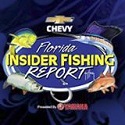 As we move into mid-April, the seatrout are coming out of the deeper canals and channels and moving towards the shallow water grass flats to spawn. From now through early June, you’ll not only find good numbers of seatrout in the bays, but also the largest fish of the year.
As we move into mid-April, the seatrout are coming out of the deeper canals and channels and moving towards the shallow water grass flats to spawn. From now through early June, you’ll not only find good numbers of seatrout in the bays, but also the largest fish of the year. Along with the seatrout, the pinfish have just hatched and are starting to reach a size that makes a good seatrout bait. That’s good and bad. Good because a three to five inch pinfish is a great trout bait. Bad, because there’s so many pinfish on the flats that it’s difficult to fish with live shrimp because the pinfish eat the legs off the shrimp and kill them, and then eat the rest of it before the trout can find it. If you want to use pinfish, it’s best to fish them on a cork, and I like the types of corks that rattle and make a lot of noise. Seatrout really react to sound, both positively and negatively. If you make too much noise by banging around in the boat or starting the engine, the trout will leave the area or shut down and stop feeding. But you can draw trout to your baits with the sound of a rattling cork, which sounds like schooling baitfish and shrimp.
Hook the pinfish through the back and just in front of the dorsal fin using a 2/0 to 4/0 VMC circle hook, and about 14 inches of 20 pound Suffix fluorocarbon leader. Place the cork a distance from the bait that will keep it from being able to swim into the grass and hide—usually around 18 inches. We’ll sue the same technique with croakers and swamp minnows.
Live pilchards are another great trout bait, and the fish really like them this time of the year because they have a lot of fat in their bodies, and the trout need that fat to nourish their eggs and make the float. So the trout are already looking for a food that has a lot of fat in it.
If live bait isn’t your game, soft plastic jerk baits are deadly on trout this time of the year. Because the water has a little bit of a brown stain to it, the colors like rootbeer, dark green, chartreuse and watermelon red glitter work well. Any time I’m trout fishing with soft plastics, I like to throw the larger 5 to 8 inch jerkbaits, because I think the larger fish like them more than they do the small 3 inch grubs.
All the trout fishing we do is in open water, so 7.5 foot rods and 10-pound braided line is what we use. The longer rod and thinner diameter braid will allow you to make a longer cast and get the lure or bait farther from the boat where the trout are less likely to detect your presence. I’ll use a 15-pound fluorocarbon leader for lures and 20-pound Suffix fluorocarbon for live bait fishing, just because we get a lot of other species when we use live bait that might have a more abrasive mouth.
There’s also a lot of mullet in the bays in April and May, so you want to look for the mullet schools, which the trout seem to dog a lot. Mullet are herbivores that eat grass, so they’re always digging in the grass, which kicks up the shrimp and other small fish that the trout like to feed on. Find the mullet, and then work your lures and baits around the edges of the mullet schools, and you can’t go wrong.
Spring rainfall also plays a role in determining where the trout will be holding. Spotted seatrout like a higher salinity level, and often that’s also where the bait will be gathered. If there’s not a lot of rainfall, the fish will be more in the upper part of the bays, but if there is a lot of rain, they get pushed down to the saltier areas by the runoff.
The average seatrout will be from one to three pounds, but we catch a lot of fish over five pounds this time of the year. Since they’re spawning, most of the trout are full of roe, so I always recommend that anyone targeting the trophy fish release any of the really big trout they catch and save the smaller fish for the table. Those big breeders not only lay a lot more eggs and put more fish into the bay, but they are also faster growing fish, and we want to keep those big trout genetics in the fishery.

